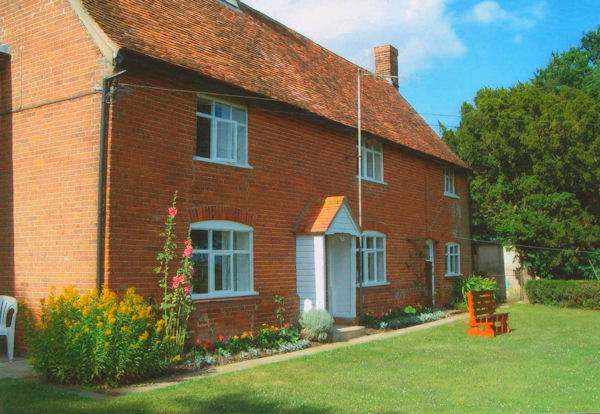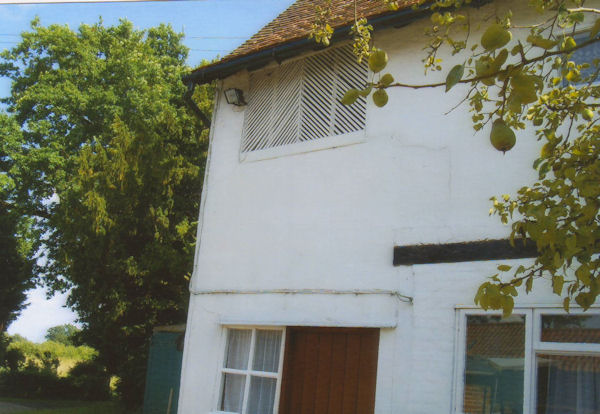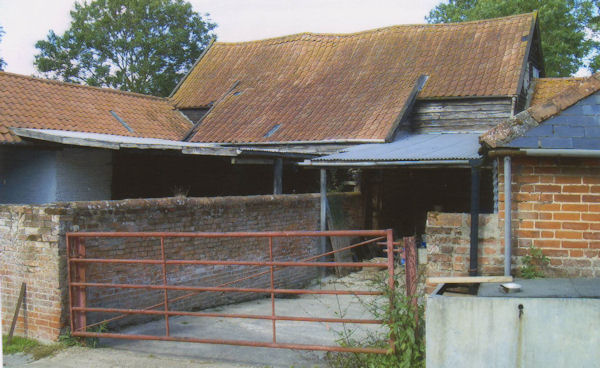

DANIEL SEWELL AND RUBBLESTONE FARM
By Diana Kennedy
This article was originally published in the December 2009 edition of Soul Search, the journal of The Sole Society
 During
the summer I was able to spend a week on the farm where my x3 great grandfather
Daniel Sewell farmed.
During
the summer I was able to spend a week on the farm where my x3 great grandfather
Daniel Sewell farmed.
Using tithe and modern day Ordnance Survey maps, I had been able to pinpoint the farm in Kelsale, Suffolk and had spent many holidays exploring the surrounding area. Earlier this year I discovered that the farmhouse had an attached cottage that was a holiday let. I immediately contacted the present owners Frank and Hilda Rowe and arranged for myself and husband David to stay for a week. Although the attached cottage was not built when Daniel was living there, it was very exciting to walk on the land and to be able to see inside the farmhouse and barns.
Rubblestone Farm is set in East Green, in Suffolk. It is about a mile out of the village of Kelsale and still surrounded by open farmland. The farm then as now is of 42 acres of both arable and pasture land. Most of the fields retain the names cited on the tithe maps of 1843, such as Home field and Starve Lark. The name of Rubblestone Farm was not used before about 1901, which is the first census to use the name. Before 1901 in censuses and other documents reliance is made on description of the land being in East Green. How it came by the name is not known, the farmhouse is certainly not made of rubble stone.
Rubblestone farmhouse was built in the 17th century and is a timber framed structure with wattle and daub, the front at some point being covered in brick. The front has three upper and three lower windows with a main door and a half blocked door. At the rear on the upper story is a large vent which apparently was to allow air into the cheese loft where cheeses were laid out on tables to mature. The main barn was also built at the same time and like the house would originally have been thatched although both are now tiled. Other out buildings including an old pig sty were built at a later date and the attached cottage where we stayed was built in the 1890’s.
The farmhouse has now been modernised but the original beams are still in place, and the barns are still standing, the original only just so. Frank remembers that when they moved to the farm in 1938 there was no running water and his father would drive the cart to the village to fill churns with water. There are two ponds by the farmhouse left from where the clay was dug out to be used for building the farmhouse.
In the 1841 census, Daniel Sewell was living at the farm with his second wife Elizabeth and son Jonathan, my x2 great grandfather and one servant girl. Jonathan left the farm for London soon after, following his sister and a brother. Another brother remained in the area as an Ag Lab. In 1851 Daniel and Elizabeth are again recorded as living at East Green with a servant.
However the tithe apportionments of 1843 show that the farm was owned by one of his younger brothers, Joseph. This is a mystery as Joseph, with his wife Letitia, was a tenant farmer on other land in adjoining Yoxford. I have evidence that Sewells were farming in the area from the late 1700’s and Daniel and Joseph’s father John also a farmer had died in 1839. I believe that his land as was often the order of the day went to his eldest son also John. So it is a mystery how Joseph, a younger son, owned land at Kelsale, my theory is that he ‘inherited’ from his wife Letitia nee Hurren.
Daniel died in 1853, and according to his death certificate he broke his neck in a fall. So far I have been unable to find a coroner’s or newspaper report or even to discover where he is buried. Although his wife Elizabeth did not die until 1858 she must have moved out, because the contents of the farm and farmhouse were sold in 1854. The advertisement for the sale show a little of the kind of farming that Daniel practiced. Among the contents for sale were 5 milch sic cows and a steer, two breeding sows, fowls and two cart mares and a bay harness cob. There were several carts and wagons and a gig, plough, harrow, and a hand chaff cutter. There were also brewing tubs and beer casks as well as a barrel churn, butter keeler and cheese boxes. Did Daniel use the cheeses loft to dry his cheese? I think it is quite likely.
The 1861 census shows that Joseph, now retired, and his wife Letitia had moved into the farm at East Green. As Joseph aged the farm was managed by his grandson Chester. Joseph and his wife both died in 1882 and the farm was left by Joseph to his son William Hurren Sewell, his grandson John Joseph Barker and a friend Anthony Hurren. Was Anthony related to Letitia? Chester does not appear to have inherited, possibly as he was in financial difficulties and later was declared bankrupt. Joseph had taken out a mortgage for £1000 on the farm, and had already given Chester a piece of land and cottage. William obviously did not need the farm as he was a successful farmer at nearby Vale Farm at Middleton, and so the farm was sold. We spent a very pleasant evening with local historian Janet Barnes who has researched the farms around Middleton including Vale Farm.
The auction took place at the Bell Hotel, Saxmundham on 2nd August 1882. The farm was advertised as having an excellent farmhouse, part of which could be utilized as a separate residence, with 42acres of highly productive and well cultivated arable and pasture land occupied by Chester Sewell. The farm was bought by a Mr John Timms Whitehead for £1,550. An adjoining field was sold for £76.
It is interesting that the farmhouse was advertised as being possible to be used for housing two families. As there were two staircases, presumably one was for use as entry to the cheese loft. Although according to Frank and Hilda there was an oven at each end. There is however no evidence that the farmhouse was used as two residences.
In 1890 the farm was then sold by John Whitehead to a Mr Robert Flick a local land agent and auctioneer. Robert Flick died in 1913 and in his Will he left Rubblestone Farm, now occupied by a William Moore, to his daughter Adeleine Turner. I am not sure who then owned the farm until 1938 when Frank Rowe’s parents bought it.
Frank arrived as a very young child in 1938 and eventually took over from his father. When Frank married Hilda they lived in the attached cottage until after his parents died. Then they moved into the farmhouse and modernised it, although by then it had acquired running water. Like his father he kept a herd of milking cows until the European Union rendered such farms unprofitable. Frank is retired now but still keeps chickens and geese, while renting out the fields he keeps one for hay. He also tends his garden, which was full of vegetables and flowers when we were there. While he lets out some of the fields he still keeps his hand in with the hay.
Frank is very keen on local history and has written a little book on the village of Kelsale. He had asked his solicitor for copies of an indenture for the farm from 1890 detailing the sale of the farm by William Hurren Sewell that he gave to me. Frank remembers watching the planes in the Second World War, when there were airfields near by. Rural life in the war was far from quiet, particularly when a bomb fell on a neighbouring farm causing damage at Rubblestone Farm. He also remembers an American plane crashing nearby. He showed us his collection of miscellany found around the farm, including a silver Elizabeth1 coin, pottery and a sheep bell as well as bits of aircraft and German propaganda leaflets dropped over the fields in the war.
It was lovely to walk in the footsteps of Daniel and to see the beautiful countryside that is little changed from when he was farming there in the 1840’s. I am sure we will be back, and hopefully learn a little bit more about Rubblestone Farm.
The following photos show the Cheese Vent and The Barn

